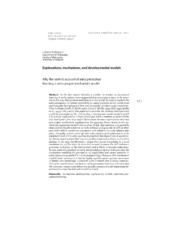Приказ основних података о документу
Explanations, mechanisms, and developmental models. Why the nativist account of early perceptual learning is not a proper mechanistic model
Objašnjenja, mehanizmi i razvojni modeli. Zašto nativistički model nije dobar mehanicistički model
| dc.contributor.editor | Jovanov, Rastko | |
| dc.creator | Radenović, Ljiljana | |
| dc.date.accessioned | 2017-11-01T10:14:58Z | |
| dc.date.available | 2017-11-01T10:14:58Z | |
| dc.date.issued | 2013 | |
| dc.identifier | 0353-5738 | |
| dc.identifier.uri | http://rifdt.instifdt.bg.ac.rs/123456789/30 | |
| dc.description.abstract | In the last several decades a number of studies on perceptual learning in early infancy have suggested that even infants seem to be sensitive to the way objects move and interact in the world. In order to explain the early emergence of infants’ sensitivity to causal patterns in the world some psychologists have proposed that core knowledge of objects and causal relations is innate (Leslie & Keeble 1987, Carey & Spelke, 1994; Keil, 1995; Spelke et al., 1994). The goal of this paper is to examine the nativist developmental model by investigating the criteria that a mechanistic model needs to fulfill if it is to be explanatory. Craver (2006) put forth a number of such criteria and developed a few very useful distinctions between explanation sketches and proper mechanistic explanations. By applying these criteria to the nativist developmental model I aim to show, firstly, that nativists only partially characterize the phenomenon at stake without giving us the details of when and under which conditions perception and attention in early infancy take place. Secondly, nativist start off with a description of the phenomena to be explained (even if it is only a partial description) but import into it a particular theory of perception that requires further empirical evidence and further defense on its own. Furthermore, I argue that innate knowledge is a good candidate for a filler term (a term that is used to name the still unknown processes and parts of the mechanism) and is likely to become redundant. Recent extensive research on early intermodal perception indicates that the mechanism enabling the perception of regularities and causal patterns in early infancy is grounded in our neurophysiology. However, this mechanism is fairly basic and does not involve highly sophisticated cognitive structures or innate core knowledge. I conclude with a remark that a closer examination of the mechanisms involved in early perceptual learning indicates that the nativism / empiricism debate (as usually construed in developmental literature) is wrong headed and should be closed. | eng |
| dc.format | 24 4 (2013) 161-180 | |
| dc.format | application/pdf | |
| dc.language | en | |
| dc.rights | openAccess | |
| dc.rights.uri | https://creativecommons.org/licenses/by-nc-nd/4.0/ | |
| dc.source | Filozofija i društvo / Philosophy and Society | mul |
| dc.subject | mechanism | |
| dc.subject | development | |
| dc.subject | explanatory models | |
| dc.subject | nativism | |
| dc.subject | perceptual learning | |
| dc.title | Explanations, mechanisms, and developmental models. Why the nativist account of early perceptual learning is not a proper mechanistic model | eng |
| dc.title | Objašnjenja, mehanizmi i razvojni modeli. Zašto nativistički model nije dobar mehanicistički model | sr |
| dc.type | article | |
| dc.rights.license | BY-NC-ND | |
| dcterms.abstract | Раденовић, Љиљана; Објашњења, механизми и развојни модели. Зашто нативистички модел није добар механицистички модел; | |
| dc.citation.spage | 161 | |
| dc.citation.epage | 180 | |
| dc.identifier.doi | 10.2298/FID1304161R | |
| dc.type.version | publishedVersion | |
| dc.identifier.fulltext | http://rifdt.instifdt.bg.ac.rs/bitstream/id/1286/Why__Nativist_n.pdf |

